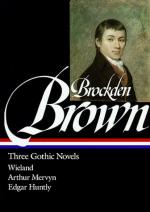|
This section contains 15,099 words (approx. 51 pages at 300 words per page) |

|
SOURCE: "The Writer as Bourgeois Moralist," in The Romance of Real Life: Charles Brockden Brown and the Origins of American Culture, The Johns Hopkins University Press, 1994, pp. 131-63.
In the following essay, Watts purports that Brown 's last two novels, Clara Howard and Jane Talbot mark Brown's transition from the radicalism of his earlier novels to the middle-class, moralistic stance of his later essays and journalistic endeavors. Watts argues that in both Clara Howard and Jane Talbot, Brown uses "sentimental strategies and domestic devices" to present his belief that success and happiness can be achieved through a balance of male ambition and female self-restraint.
On or about April 1800 Charles Brockden Brown changed. In a despondent letter to his brother James, the young author confessed that "gloominess and outof-nature incidents" had tainted his early novels. The time had come, he wearily admitted, "for dropping the doleful tone and assuming...
|
This section contains 15,099 words (approx. 51 pages at 300 words per page) |

|


